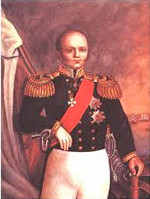
Birthday anniversary of Admiral Dmitry N. Senyavin
August 6 (17), 1763 in the village of Komlevo, Borovsky district of the Kaluga province was born the future Admiral Dmitry N. Senyavin.
Dmitry belonged to a noble family, whose fate had been closely linked with the history of the Russian Navy since its inception. His ancestor, Nahum Senyavin, became famous for a major naval victory in the battle near the island of Ezel in 1719, during the Northern War. Dmitry’s father, Vice-Admiral Nikolai Senyavin, served as military governor of the port of Kronstadt in 1773-1775.
At the age of ten, Dmitry Senyavin was sent to the Gentry Sea Cadet Corps. In November 1777, the young man was promoted to midshipman. In 1778, he made his first voyage under the command of Captain Burke from Kronstadt to Revel, and from there to the North Pacific, to the North Cape and back. In May 1780, having excellently passed the exams for the rank of officer, Senyavin was promoted to warrant officer and was appointed to the ship "Prince Vladimir", which was part of a squadron sent to Lisbon (Portugal) to maintain an armed neutrality. In 1782, Senyavin was sent to continue his service in the Sea of Azov, where he was responsible for protection of Russian ships from the Turkish Navy.
After 1783, Senyavin served as adjutant of Rear Admiral F. F. McKenzie charged with the strengthening of the Akhtiar Bay (Sevastopol). Every summer he went to sea, in winter was involved in the construction of the port of Sevastopol. In 1786, Senyavin commanded the packet boat "Karabut" which shuttled between Sevastopol and Istanbul. Diplomatic affairs led with Dmitry to Prince G. A. Potyomkin, who quickly appreciated the skills of the young officer.
During the Russian-Turkish war of 1787-1791, Senyavin saved from a storm the ship “Preobrazheniye” off the coast of Varna, where he served as flag-captain under the Rear Admiral M. I. Voinovich. During the siege of Ochakov by Russian forces, Senyavin destroyed about a dozen of Turkish merchant ships and managed to divert the attention of the Turkish fleet from the area of hostilities. In December 1788, Dmitry was awarded the Order of St. George, 4th class. Consistently commanding such warships as "Martyr Leontius," "St. Vladimir," "Joseph II,” “Navarkhia," he distinguished himself in the defeat of the Turkish Navy during the Battle of Cape Kaliakra in the summer of 1791, and in the battle near Varna. After the conclusion of peace with Turkey, Senyavin continued to serve in the Black Sea.
In early 1796, Dmitry Senyavin was promoted to captain 1st rank and appointed the commander of the 74-gun ship "Saint Peter", on board of which he took part in the Mediterranean expedition of F. F. Ushakov. During a few operations, with the direct contribution of Senyavin, the island of Santa Maura and Corfu were liberated. Returning after that to Sevastopol, Dmitry was appointed captain of the port of Kherson, and in 1803 was promoted to rear admiral and became the commander of the Sevastopol port. In 1804 he was transferred to the Baltic Sea, to the post of the senior naval officer of Revel.
In 1804, Napoleon enhanced his actions in the Balkans and Italy. Due to the threat to Russia's interests in the Mediterranean, Russian government sent there a squadron of the Baltic Fleet, under the command of Vice Admiral Senyavin, thus barring to the French the way to the Balkans. In December 1806, Turkey, under pressure from Napoleon, declared war on Russia. Commanding the Russian Navy, Senyavin had prevented the capture of the Ionian Islands by the French, defeated the Turkish fleet in the Battle of the Dardanelles and the Athos (1807), which provided for the rule of Russian Navy in the entire Aegean Sea.
In June of 1807, a peace treaty was signed in Tilsit between Alexander I and Napoleon; Russia returned to France all the islands and lands on the Balkan Peninsula and withdrew its troops from the Mediterranean Sea. By order of the Emperor, Senyavin ceased the hostilities and sailed home in September. However, in late October, Russian ships were blocked in Lisbon by the superior forces of the British Navy. This action was taken by the British in response to Russia's joining the continental blockade of the UK under the Treaty of Tilsit. After long negotiations, in August 1808, Dmitry Senyavin concluded an agreement with the British on the internment of the squadron in British ports during the siege.
In September 1808 August 1809, Senyavin remained off the harbor at Portsmouth and then was permitted to take the squadron to Riga. On his return to Russia in autumn of 1809, he fell out of favor with Alexander I and was actually demoted, returning to his duties as commander of Revel fleet, and in 1813 he resigned.
Senyavin returned to the service only after the accession of Nicholas I. In 1825, the Emperor appointed Senyavin adjutant general, then commander of the Baltic Fleet. In 1826, he was promoted to the rank of Admiral.
In 1830, due to the poor health, Senyavin was forced to resign. April 5 (17), 1831 Admiral died and was buried in St. Petersburg, in the Church of the Holy Spirit, Alexander Nevsky Lavra.
Lit.: Дивин В., Фокеев К. Адмирал Д. Н. Сенявин. М., 1952; Дмитрий Николаевич Сенявин (1763-1831 гг.): [Галерея рос. флотоводцев] // Мор. сборник. 1992. № 10. С. 32; Плавание эскадры под начальством вице-адмирала Сенявина в Средиземное море и возвращение команды её в Россию, 1805-1809. Кронштадт, 1885; Тарле Е. В. Экспедиция адмирала Д. Н. Сенявина в Средиземное море (1805-1807). М., 1954; Шапиро А. Л. Адмирал Д. Н. Сенявин. М., 1958.
Based on the Presidential Library’s materials:
Black Sea Fleet Museum opened in Sevastopol // On this day. 26 September 1869;

